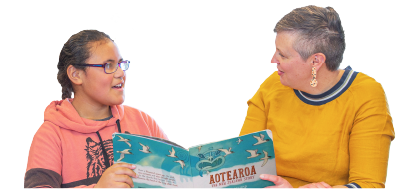Teacher expectations
Show video transcript
Title slide: Teacher expectations
Gary Roberts, Principal, Hornby Primary, Christchurch, facing camera
If you truly know the learner you are going to know their cultural background. You are going to know the language that they speak at home, you're going to be aware of what they do in the weekend. Do they go to church on a Saturday? Do they go to church on a Sunday? So we have a very strong emphasis on knowing the learner.
Images of Hornby Primary
We have high expectations for all of our learners so, for example, when Tufulasi walks in through the gate he should not have to take off his Tongan or his Samoan backpack to be successful at Hornby Primary School – so he will be successful as Samoan or Tongan or Cook Island. Another thing around that is that the expectation that our learners will be present and engaged at school on a daily basis.
Images of Manurewa High School
Reverend Pennie Vaione Otto, Deputy Principal, Manurewa High School, facing camera
With dreams and aspirations around our students here, because we have such a diverse group, who've got over 2100 students here of mixed ethnicity. We’re the largest Pasifika school in the country, which is the world. And that's because we house over a thousand Pasifika students in this space. And so there is still that I guess that anomaly where our students aren't achieving at the top end of stuff.
So earlier this term we held our academic prize giving. And we had a lot of really good Pasifika representation in merit and excellence endorsements for level one. We had really good Pasifika representation in merit and excellence endorsements in level two in NCEA. But then you get to level three the numbers really dwindled to the handful. And then you get to scholarship and we have none. And so it is around highlighting that for our kids that they can get there. They just need to know how to get into that scholarship type of space that will lead them into different tertiary pathways and different career progressions.
Because we also have the largest trades academy space here in the country, some of our kids you know by obvious choice, kind of get swept up into that space of the trades academy but we've got the goods and it's just about making sure that our kids know how to get into that really good space of getting scholarships. You know NCEA scholarship and you know just NCEA level three merit, excellence endorsement to qualify for good scholarships into universities.
This video illustrates how teacher expectations influence their learners’ experiences of learning. The featured teachers talk about understanding the learner’s cultural background. Many learners bring their cultural ways of being into the school, and this represents their identity. Teacher expectations lead to student self-confidence and belief; it motivates the learners to aim high and get to places where few or no Pacific learners are represented, for example, one teacher talks about scholarships.
Reflections for individual teachers
This video considers the expectations different teachers have for Pacific learners, their cultural background and their learning. As you watch this video:
- Write and share your understanding of a teacher’s lower or higher expectations for Pacific learners. We recommend that you develop a conceptual understanding of the implications teacher expectations have for a learner’s learning.
- Explore and write down your perceptions of how your expectations for your different learners are shaped. How do your expectations influence your practice and student outcomes?
- What do you think are other contributing factors to a Pacific learner’s success aside from the maintenance of their cultural identity, high expectations by both teachers and parents, home-school relationships, parental and community support, the role of community and church, and culturally responsive teaching?
Reflections for staff or departments
If you are watching this story as a staff member or member of a department team, you may have examined what your staff understood about teacher expectations with a particular focus on Pacific learners.
- In groups, unpack what having high expectations for Pacific learners looks like and share your understanding of the biggest barriers to improving, or becoming high achievers, faced by Pacific learners.
- Think of ways that you can co-construct the curriculum and involve your Pacific learners in assessment as a way of ensuring your school is responding to the specific strengths of individual learners and Pacific needs (rather than working from generalised assumptions). Set up activities that encourage meaningful exchanges between your teaching staff and Pacific learners as part of planning curriculum and pedagogy.
- Focus on the training needs of your teachers and use Tapasā as a guiding document to respond to specific cultural practices, expectations, and awarenesses to grow your staff’s cultural understanding. This includes critically reflecting on their own expectations and teaching behaviours in classrooms.

